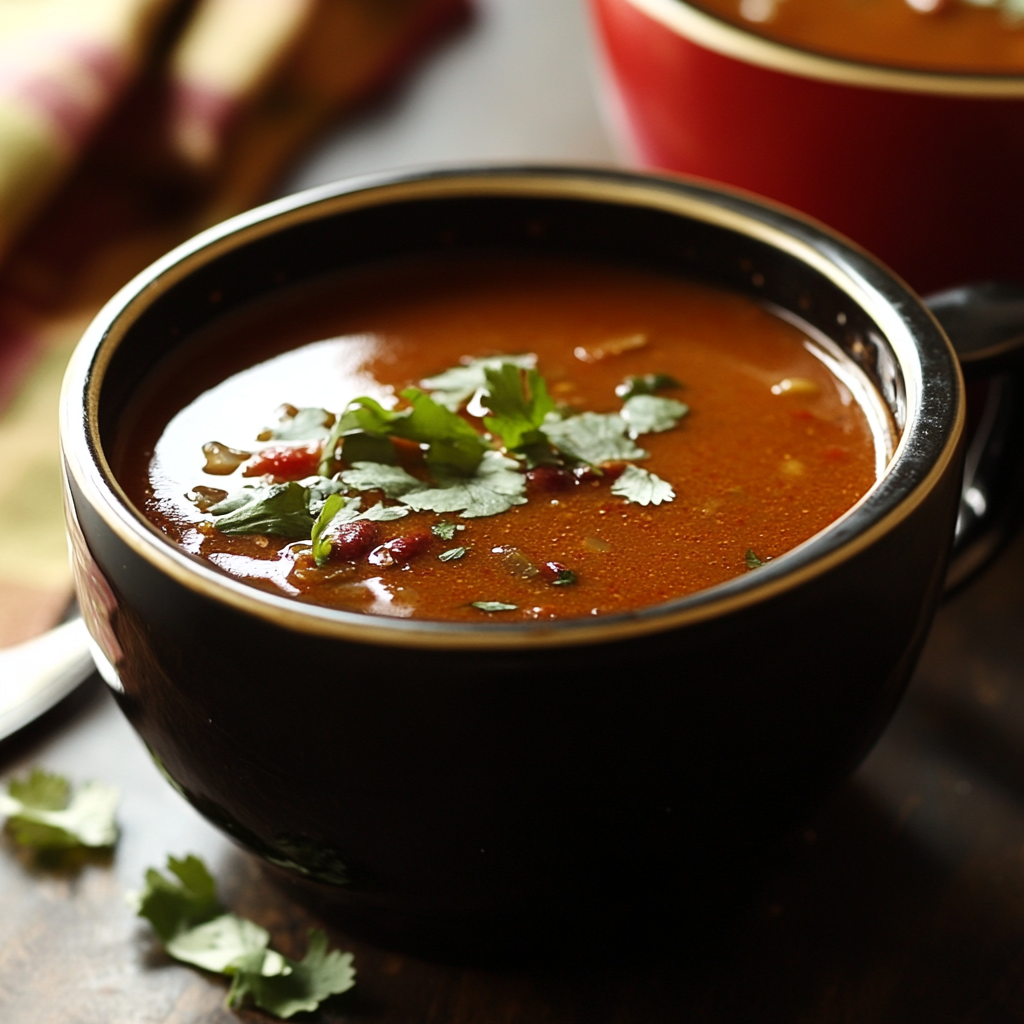Revised Introduction with Keyphrase
Chili soup is a comforting and versatile dish that combines the hearty flavors of traditional chili with the lighter, brothier texture of a soup. This chili soup recipe is perfect for busy weeknight dinners, cozy family meals, or even entertaining guests. Packed with bold spices, protein-rich ingredients, and endless options for customization, it’s a dish that can be tailored to suit any taste or occasion. Whether you prefer a classic version or want to experiment with unique variations, this recipe will quickly become a household favorite.
Differences Between Chili and Chili Soup
The key distinction lies in the texture and liquid content:
- Chili: A thick, stew-like dish made with beans, meat, tomatoes, and spices, where the focus is on a rich and hearty consistency.
- Chili Soup: A thinner, broth-based variation of chili that still incorporates the same core ingredients but has a soupier texture, making it lighter and more versatile.
Chili soup is an ideal choice for those who want the warmth and flavor of chili in a less dense format, perfect for sipping or serving alongside other dishes.
Why Chili Soup Is a Versatile Dish
Chili soup’s adaptability makes it a favorite among home cooks. It can be customized to suit dietary preferences, such as vegetarian, vegan, or low-carb options, and easily adjusted for varying spice levels. Whether served as a standalone dish, paired with cornbread, or topped with cheese and sour cream, chili soup works well for casual family dinners, potlucks, or game-day gatherings. Its blend of flavors and textures ensures it appeals to a wide range of palates.
2. History of Chili Soup
Origins of Chili-Based Dishes
Chili-based dishes have a rich history rooted in the culinary traditions of Central America and the American Southwest. Early versions, such as “chili con carne,” featured simple combinations of meat, chili peppers, and spices. These dishes were born out of the need for hearty, flavorful meals that could be prepared with minimal ingredients. Over time, beans, tomatoes, and other staples were added, transforming chili into a beloved comfort food.
How Chili Soup Evolved
Chili soup likely evolved as a lighter alternative to traditional chili, incorporating more liquid to create a soup-like consistency. This adaptation made it more versatile and appealing to those looking for a meal that wasn’t as heavy. The addition of broth allowed cooks to stretch ingredients further, making chili soup an economical choice for feeding larger groups. It also opened the door to experimenting with flavors, such as adding corn, vegetables, or different types of beans.
Regional Variations in Chili Soup Recipes
Chili soup recipes vary widely across regions, reflecting local tastes and ingredients:
- Midwest: Often includes ground beef, kidney beans, and a tomato-based broth, seasoned with mild spices for a family-friendly flavor.
- Southwest: Features bolder spices, green chiles, and sometimes a smoky twist with ingredients like chipotle peppers.
- Vegetarian and Vegan Variants: Popular in health-conscious regions, incorporating plant-based proteins like lentils or tofu alongside beans and vegetables.
- Tex-Mex Influence: Adds elements like corn, queso fresco, or lime to complement the spicier profiles of the dish.
This rich history and regional diversity showcase the adaptability and universal appeal of chili soup, making it a timeless and cherished recipe across cultures.
3. Essential Ingredients for Chili Soup
Proteins: Ground Beef, Turkey, or Vegetarian Options
Protein is the cornerstone of chili soup, providing both substance and flavor.
- Ground Beef: A classic choice that offers a rich and hearty flavor, perfect for traditional chili soup recipes.
- Ground Turkey: A lighter alternative that still delivers a satisfying texture and taste, ideal for those seeking a leaner option.
- Vegetarian Options: Plant-based proteins such as lentils, chickpeas, or tofu are excellent substitutes, allowing vegetarians and vegans to enjoy the dish without compromising on heartiness.
Beans: Kidney, Pinto, or Black Beans
Beans are essential for adding texture, nutrition, and a creamy contrast to the soup’s broth:
- Kidney Beans: Known for their firm texture and ability to soak up flavors, they are a staple in most chili soups.
- Pinto Beans: These beans have a softer texture and slightly sweet, nutty flavor, making them a great addition.
- Black Beans: With their rich, earthy taste, black beans work well in both traditional and spicier chili soup recipes.
A mix of beans can create an interesting depth of flavor and enhance the overall appeal of the soup.
Fresh Vegetables
Fresh vegetables not only contribute flavor but also add vibrant color and texture:
- Onions and Garlic: Form the aromatic base, providing depth and savoriness.
- Bell Peppers: Add a sweet, crisp texture that complements the spices.
- Tomatoes: Use diced or crushed tomatoes for the body of the broth, contributing acidity and balance.
Optional additions like corn, zucchini, or carrots can enhance the soup’s complexity and nutritional profile.
4. Choosing the Right Spices
Common Chili Spices: Cumin, Paprika, Chili Powder
The bold flavors of chili soup come from its carefully selected spices:
- Cumin: Adds an earthy, warm undertone that anchors the dish.
- Paprika: Provides a smoky sweetness or mild heat, depending on the variety used.
- Chili Powder: The star spice, delivering the signature heat and vibrant red color associated with chili-based dishes.
How to Balance Heat and Flavor
Creating the perfect chili soup involves balancing heat with flavor:
- Start with a moderate amount of chili powder and taste as you cook, adjusting the level of spice incrementally.
- To enhance flavors without adding heat, incorporate spices like garlic powder, onion powder, or smoked paprika.
- Cool the heat by adding a touch of sugar, sour cream, or cheese if the soup becomes too spicy.
Customizing Spice Blends
One of the joys of chili soup is its adaptability to personal preferences:
- For a smoky profile, add chipotle powder or smoked paprika.
- For extra heat, include cayenne pepper or fresh diced jalapeños.
- Experiment with global influences, such as using curry powder for an Indian twist or oregano and cinnamon for a Mediterranean flair.
With the right combination of these essential ingredients and spices, you can create a chili soup that is flavorful, satisfying, and uniquely yours.
5. Step-by-Step Instructions for Chili Soup
Preparing Ingredients
- Gather Ingredients: Assemble all your ingredients, including proteins, beans, vegetables, spices, and broth.
- Chop Vegetables: Dice onions, garlic, and bell peppers, and prepare any additional vegetables like carrots or zucchini.
- Prepare Protein: If using meat, ensure it’s thawed and ready to cook. For vegetarian options, drain and rinse canned beans or prepare plant-based protein substitutes.
Cooking Techniques for Perfect Consistency
- Sauté Aromatics: Heat a large pot over medium heat and add a drizzle of oil. Sauté diced onions and garlic until they become fragrant and translucent.
- Cook Protein: Add ground beef, turkey, or plant-based substitutes to the pot. Brown the protein, breaking it into small pieces, and cook until no longer pink. If necessary, drain any excess fat.
- Add Vegetables: Stir in bell peppers and cook for 3–4 minutes until softened.
- Incorporate Beans and Tomatoes: Add the beans, diced tomatoes, and tomato sauce. Stir to combine and let the flavors meld.
Adjusting the Thickness with Broth
- Add Broth: Pour in 2–3 cups of chicken, beef, or vegetable broth, depending on your desired consistency.
- Simmer: Reduce the heat to low and allow the soup to simmer for 20–30 minutes. This helps the flavors meld and thickens the soup slightly.
- Adjust Consistency: If the soup is too thick, add more broth in small increments. For a thicker soup, mash some of the beans or simmer uncovered to reduce the liquid.
6. Variations of Chili Soup
Vegetarian Chili Soup
Replace the meat with hearty vegetables like sweet potatoes, zucchini, or mushrooms. Add an extra variety of beans such as black beans, kidney beans, and chickpeas for protein and texture. Enhance the flavor with Brooks Chili Seasoning or a mix of cumin, chili powder, and smoked paprika. Vegetable broth works perfectly to tie the flavors together.
White Chili Soup with Chicken
For a lighter and creamy twist, use shredded chicken and white beans such as cannellini or great northern beans. Swap the tomato base for chicken broth and add green chiles for a mild kick. Stir in a dollop of sour cream or cream cheese toward the end of cooking for a rich and velvety texture. Top with shredded Monterey Jack cheese and a squeeze of lime for extra brightness.
Spicy Tex-Mex Chili Soup
Amp up the spice with diced jalapeños, chipotle peppers in adobo sauce, or cayenne powder. Use a mix of black beans and pinto beans for a Tex-Mex vibe. Add corn kernels, fire-roasted tomatoes, and a splash of lime juice to enhance the flavor. Top with crispy tortilla strips, diced avocado, and fresh cilantro for an authentic Tex-Mex finish.
These step-by-step instructions and variations ensure you can create chili soup that matches your tastes, dietary preferences, and occasion. Whether classic, creamy, or spicy, chili soup is a satisfying and customizable dish.
7. Top Toppings for Chili Soup
Cheese, Sour Cream, and Green Onions
These classic toppings elevate chili soup with a mix of creamy, savory, and fresh flavors:
- Shredded Cheese: Cheddar, Monterey Jack, or a Mexican blend adds richness and a melty texture.
- Sour Cream: A dollop provides a cooling contrast to the soup’s heat and adds a silky finish.
- Green Onions: Chopped green onions bring a pop of freshness and mild onion flavor.
Unique Toppings: Avocado, Tortilla Chips
For a creative twist, try these unique toppings:
- Avocado: Diced or sliced avocado adds creaminess and a mild flavor that balances spicy soup.
- Tortilla Chips: Crushed tortilla chips or strips introduce a satisfying crunch and a hint of saltiness.
- Other Ideas: Add pickled jalapeños for heat, lime wedges for tanginess, or a drizzle of hot sauce for extra spice.
Pairing Sides Like Cornbread
Cornbread is a classic side dish for chili soup, offering a slightly sweet contrast to its bold, savory flavors. Serve it warm with butter or bake it with add-ins like jalapeños or cheddar for a flavor boost. Other great side options include crusty bread, garlic toast, or a simple side salad.

8. Chili Soup for Different Occasions
Quick Weeknight Dinners
Chili soup is a lifesaver for busy weeknights. It’s quick to prepare, especially when using pantry staples like canned beans and tomatoes. Serve it with simple sides like tortilla chips or a green salad for a complete, satisfying meal.
Perfect for Parties and Gatherings
Chili soup is an excellent option for entertaining. Its versatile flavor appeals to a wide range of palates, and it’s easy to make in large batches. Set up a chili soup bar with toppings like cheese, sour cream, avocado, and tortilla chips, allowing guests to customize their bowls. Pair it with cornbread muffins or breadsticks for a crowd-pleasing spread.
Chili Soup as a Winter Comfort Food
Warm, hearty, and full of bold flavors, chili soup is the ultimate winter comfort food. Its rich spices and warming broth make it perfect for cozying up on cold days. Pair it with a hot beverage like mulled cider or a spiced tea for an extra comforting touch.
With its variety of toppings, sides, and serving possibilities, chili soup is a versatile dish that fits any occasion, from casual dinners to festive gatherings.
9. Slow Cooker and Instant Pot Versions
How to Adapt the Recipe for a Slow Cooker
The slow cooker is perfect for chili soup, allowing flavors to develop over time with minimal effort.
- Preparation: Brown the meat and sauté the onions and garlic on the stovetop first for deeper flavor.
- Transfer Ingredients: Add the cooked meat, vegetables, beans, tomatoes, broth, and spices to the slow cooker.
- Cook Time: Set the slow cooker on low for 6–8 hours or high for 3–4 hours. Stir occasionally if possible.
- Final Touches: Adjust the seasoning and add any delicate toppings like fresh herbs or lime juice just before serving.
Using an Instant Pot for Faster Results
The Instant Pot cuts cooking time dramatically while still delivering robust flavors.
- Sauté Mode: Use the sauté function to brown the meat and cook the onions and garlic directly in the Instant Pot.
- Add Ingredients: Layer in the beans, vegetables, tomatoes, broth, and spices.
- Pressure Cook: Seal the lid and cook on high pressure for 10–15 minutes. Allow a natural pressure release for 10 minutes before opening.
- Thicken if Needed: Use the sauté function again after pressure cooking to reduce the soup if it’s too thin.
Tips for Flavor Enhancement
- Add a splash of lime juice or apple cider vinegar after cooking to brighten the flavors.
- For smoky depth, stir in a spoonful of chipotle peppers in adobo sauce or smoked paprika.
- Finish with fresh toppings like cilantro or diced avocado for added freshness and texture.
10. Nutritional Benefits of Chili Soup
High-Protein Options
Chili soup is naturally high in protein when made with ingredients like ground meat, poultry, or plant-based alternatives. Adding beans such as black, kidney, or pinto beans further boosts protein while offering fiber for digestive health. Opt for lean ground turkey or chicken to reduce saturated fat without sacrificing protein.
Incorporating Vegetables for Added Nutrients
Adding a variety of vegetables to your chili soup enhances its nutritional profile:
- Bell Peppers: Rich in vitamin C and antioxidants.
- Carrots: Provide beta-carotene for eye health and natural sweetness.
- Zucchini: Adds fiber and vitamins with a low calorie count.
These vegetables not only add flavor and texture but also make the dish more balanced and filling.
Making It Lighter with Healthy Swaps
For a healthier version of chili soup, consider these swaps:
- Use Lean Protein: Substitute ground beef with turkey, chicken, or plant-based crumbles.
- Choose Low-Sodium Options: Opt for low-sodium canned beans and tomatoes, or make your own to control salt levels.
- Reduce Fats: Drain excess fat from cooked meat and use minimal oil during preparation.
- Add Greens: Stir in spinach, kale, or Swiss chard at the end of cooking for a nutrient boost.
With these adaptations, chili soup can be a wholesome, nutrient-packed meal that aligns with your health goals while delivering incredible flavor.
11. Common Mistakes to Avoid When Making Chili Soup
Overcooking the Beans
Beans are a key ingredient in chili soup, but overcooking them can lead to mushy or broken beans, which may affect the texture of the dish.
- Tip: If using canned beans, add them toward the end of cooking to prevent overcooking.
- For Dry Beans: Soak them overnight and cook until just tender before adding them to the soup.
Not Tasting and Adjusting Spices
Chili soup relies on a delicate balance of flavors, and failing to taste and adjust as you cook can lead to a bland or overly spicy dish.
- Tip: Taste frequently and adjust salt, heat, and other spices incrementally. Start with a small amount of chili powder or cayenne and build up to your preferred spice level.
Using the Wrong Type of Tomatoes
Tomatoes are the base of most chili soups, and the type you use can significantly impact the flavor.
- Tip: Opt for diced or crushed tomatoes for a balanced texture and flavor. Avoid using overly sweet or unseasoned tomato products unless you adjust the spices accordingly.
12. Storing and Reheating Chili Soup
Best Practices for Refrigerating
Proper storage ensures your chili soup stays fresh and flavorful:
- Cool Before Storing: Allow the soup to cool to room temperature before refrigerating to prevent condensation and preserve texture.
- Use Airtight Containers: Store chili soup in airtight containers to maintain freshness and prevent absorption of fridge odors.
- Shelf Life: Chili soup can be safely refrigerated for up to 3–4 days.
Freezing Chili Soup for Meal Prep
Chili soup freezes exceptionally well, making it an ideal option for meal prep:
- Cool Thoroughly: Let the soup cool completely before transferring to freezer-safe containers or heavy-duty freezer bags.
- Portion Sizes: Divide into individual portions for convenient reheating.
- Label and Date: Mark containers with the date to keep track of storage time. Frozen chili soup is best consumed within 2–3 months for optimal flavor and texture.
Reheating Without Losing Flavor
- Stovetop: Reheat on low to medium heat, stirring occasionally to ensure even warming. Add a splash of broth or water if the soup is too thick.
- Microwave: Heat in short intervals, stirring between each, to prevent uneven heating.
- From Frozen: Thaw chili soup overnight in the refrigerator or reheat directly from frozen over low heat, adding liquid as needed to maintain consistency.
By avoiding common mistakes and following proper storage and reheating techniques, your chili soup will remain delicious and satisfying for days or even weeks after preparation.
13. FAQs About Chili Soup Recipe
Can I Make It Vegan?
Yes, chili soup can be easily adapted for a vegan diet:
- Protein: Use plant-based alternatives like lentils, chickpeas, black beans, or tofu.
- Broth: Replace meat-based broths with vegetable broth.
- Toppings: Opt for avocado, tortilla strips, or dairy-free cheese and sour cream as vegan-friendly toppings.
How Do I Adjust the Spice Level?
- To Increase Spice: Add more chili powder, cayenne pepper, or diced chili peppers (like jalapeños or habaneros). A splash of hot sauce also works.
- To Reduce Spice: Balance the heat by stirring in sour cream, shredded cheese, or a splash of cream. Adding a touch of sugar or diluting the soup with more broth can also help.
What’s the Best Type of Broth to Use?
- Chicken Broth: Great for a milder, more savory flavor, especially in lighter chili soups.
- Beef Broth: Provides a deeper, richer flavor that pairs well with ground beef.
- Vegetable Broth: The perfect choice for vegan or vegetarian versions, offering a clean and adaptable base.
What Is the Difference Between Chili and Chili Soup?
The key difference lies in consistency and liquid content:
- Chili: Thicker and heartier, with minimal liquid, resembling a stew.
- Chili Soup: Thinner and brothier, with more liquid, making it lighter and more soup-like.
What Is the Secret to Really Good Chili?
- Layered Spices: Toast spices like cumin, chili powder, and smoked paprika to unlock deeper flavors.
- Balance: Incorporate a balance of heat, acidity (tomatoes or lime), and sweetness (a touch of sugar or cocoa powder).
- Low and Slow Cooking: Simmering chili slowly allows the flavors to meld and deepen.
What Is Chili Soup Made Of?
Chili soup typically consists of:
- Protein: Ground beef, turkey, chicken, or plant-based options.
- Beans: Black, kidney, or pinto beans for texture and nutrition.
- Vegetables: Onions, bell peppers, tomatoes, and garlic.
- Broth: Chicken, beef, or vegetable broth to create a soup-like consistency.
- Spices: Chili powder, cumin, paprika, and optional heat-enhancing ingredients like cayenne or jalapeños.
Is Beef Broth or Stock Better for Chili?
- Beef Broth: Easier to find and provides a lighter, savory base.
- Beef Stock: Richer and more flavorful due to the inclusion of bones and slow cooking. It’s ideal for enhancing the depth of flavor in meat-based chili.
Both options work well, but beef stock adds more richness to the dish. If stock isn’t available, beef broth is an excellent substitute.
14. Where to Find the Best Ingredients
Shopping Tips for Fresh Produce
- Local Markets: Visit farmers’ markets for the freshest and most flavorful vegetables like onions, bell peppers, and tomatoes. Fresh produce enhances the taste of your chili soup significantly.
- Seasonal Choices: Opt for vegetables that are in season for maximum flavor and cost-effectiveness. For example, ripe summer tomatoes or fresh winter squash can add a unique twist to your soup.
- Storage Tip: Choose firm, unblemished produce and store them properly to maintain freshness until you’re ready to cook.
Sourcing High-Quality Spices
- Specialty Spice Stores: Shop at specialty spice shops or online retailers like Penzeys or The Spice House for high-quality, fresh spices. These often have a more potent flavor compared to generic store brands.
- Whole vs. Ground: Purchase whole spices like cumin seeds and grind them at home for maximum freshness and aroma.
- Storage Tip: Store spices in airtight containers away from heat and sunlight to preserve their potency.
Best Brands for Canned Beans and Tomatoes
- Canned Beans:
- Bush’s Beans: Known for their quality and wide variety, including black beans and kidney beans.
- Goya: Offers a range of premium canned beans with excellent flavor and texture.
- Eden Foods: Provides organic, BPA-free canned beans for a healthier option.
- Canned Tomatoes:
- San Marzano: Authentic Italian-style tomatoes with a naturally sweet flavor, perfect for chili.
- Hunt’s: A budget-friendly option with reliable quality and rich flavor.
- Muir Glen: Offers organic, BPA-free tomatoes for a healthier, eco-friendly choice.
By selecting the best-quality ingredients, you can elevate the flavor of your chili soup and ensure every bowl is a delicious and satisfying experience.
To enhance the “Chili Soup Recipe” article with relevant internal links, consider integrating links to related content on the site. When discussing smoky flavors in chili soup, link to The Ultimate Brisket Chili Recipe: A Smoky, Savory Delight to guide readers toward another smoky chili option. Additionally, when mentioning creative ingredient variations, such as enchilada sauce, include a link to The Perfect Chili Recipe with Enchilada Sauce and Ground Beef for inspiration. Finally, for readers exploring spice blends or seasoning options, a link to Brooks Seasoning Chili Recipe: A Flavorful Delight can provide insights into flavor customization. These internal links will improve user navigation and strengthen the site’s overall SEO structure.
What’s the best way to store leftovers?
Keep leftovers in an airtight container in the fridge for up to 4 days. Reheat in the microwave or oven until hot and bubbly. For food safety tips, refer to USDA guidelines on leftovers .
15. Conclusion: Why Everyone Should Try Chili Soup
Chili soup is more than just a meal—it’s a comforting and versatile dish that can be enjoyed by everyone. Its combination of hearty ingredients, bold spices, and customizable flavors makes it a go-to option for any occasion, from casual weeknight dinners to festive gatherings. Whether you prefer a traditional recipe or want to explore variations like white chicken chili or spicy Tex-Mex chili soup, there’s a version to suit every taste.
Don’t hesitate to experiment with flavors and ingredients. Add your favorite vegetables, try unique toppings, or play with spice levels to create a chili soup that’s uniquely yours. The beauty of this dish lies in its adaptability, allowing you to tailor it to your preferences or dietary needs.
For success, remember to taste and adjust your seasoning, balance your flavors, and choose fresh, high-quality ingredients. With these tips, every bowl of chili soup will be a delicious, satisfying experience that warms the heart and delights the palate. So grab your ladle and get cooking—chili soup is a dish worth savoring!






4 thoughts on “Ultimate Guide to the Perfect Chili Soup Recipe”
Comments are closed.